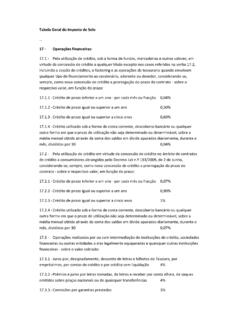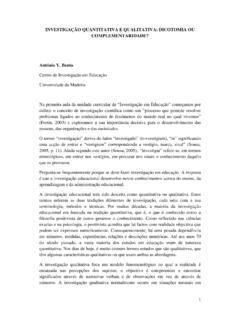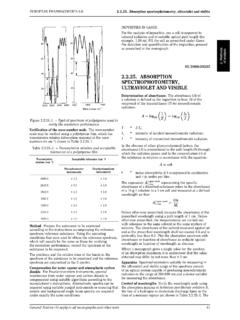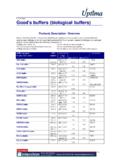Transcription of INTERPRETATION OF INFRARED SPECTRA, A PRACTICAL …
1 INTERPRETATION OF INFRARED SPECTRA, A PRACTICAL APPROACH 1. INTERPRETATION of INFRARED absorptions in the spectrum. This information can indicate whether there is backbone to the structure and, if so, Spectra, A PRACTICAL Approach whether the backbone consists of linear or branched chains. Next it is possible to determine if there is unsaturation and/or aromatic rings in the structure. Finally, it is possible John Coates to deduce whether specific functional groups are present. Coates Consulting, Newtown, USA If detected, one is also able to determine local orientation of the group and its local environment and/or location in the structure. The origins of the sample, its prehistory, and the manner in which the sample is handled all have impact 1 Introduction 1. on the final result. Basic rules of INTERPRETATION exist and, 2 The Origins of the INFRARED Spectrum 2 if followed, a simple, first-pass INTERPRETATION leading to 3 Spectral INTERPRETATION by Application of material characterization is possible.
2 This article addresses Vibrational Group Frequencies 6 these issues in a simple, logical fashion. PRACTICAL examples The Hydrocarbon Species and are included to help guide the reader through the basic Molecular Backbone 6 concepts of INFRARED spectral INTERPRETATION . Simple Functional Groups 9. The Carbonyl Group 12. Other Functional Groups Associated with Heteroatoms 13 1 INTRODUCTION. Simple Inorganics 14. 4 The PRACTICAL Situation Obtaining the The qualitative aspects of INFRARED spectroscopy are one Spectrum and Interpreting the Results 15 of the most powerful attributes of this diverse and Sample History 16 versatile analytical technique. Over the years, much has Physical Characteristics of the been published in terms of the fundamental absorption Sample 17 frequencies (also known as group frequencies) which are The Chemistry of the Sample 17 the key to unlocking the structure spectral relationships The INFRARED Sampling Method 18 of the associated molecular vibrations.
3 Applying this knowledge at the PRACTICAL routine level tends to be 5 An Overview to INFRARED Spectral a mixture of art and science. While many purists will INTERPRETATION Some Simple Rules and argue against this statement, this author believes that it Guidelines 19. is not possible to teach a person to become proficient as A Quick Diagnostic Assessment of an interpretive spectroscopist by merely presenting the an INFRARED Spectrum 20. known relationships between structure and the observed Abbreviations and Acronyms 22 spectra. Instead, the PRACTICAL approach, which has been Related Articles 22 adopted in this text, is to help the reader appreciate the References 23 visual aspects of the spectroscopy and how to interpret these relative to the structure and chemistry of the sample. This is achieved by recognizing characteristic shapes and patterns within the spectrum, and by applying the The vibrational spectrum of a molecule is considered to information obtained from published group frequency be a unique physical property and is characteristic of the data, along with other chemical and physical data from molecule.
4 As such, the INFRARED spectrum can be used as the sample. a fingerprint for identification by the comparison of the Included in the text is a discussion of the interrelation- spectrum from an unknown'' with previously recorded ships that exist between the PRACTICAL side of acquiring reference spectra. This is the basis of computer-based the spectrum, the chemistry and physics of the sample spectral searching. In the absence of a suitable reference under study, the physical interactions of the sample with database, it is possible to effect a basic INTERPRETATION of the its environment, and the impact of the structure on the spectrum from first principles, leading to characterization, spectrum. In essence, the INTERPRETATION of INFRARED spec- and possibly even identification of an unknown sample. tra is much more than simply assigning group frequencies.
5 This first principles approach is based on the fact that The spectrum is rich in information, and this article is structural features of the molecule, whether they are the intended to help the reader to extract the maximum backbone of the molecule or the functional groups attached using the knowledge available for the sample and the to the molecule, produce characteristic and reproducible acquired spectral data. One important factor to bear in Encyclopedia of Analytical Chemistry Meyers (Ed.) Copyright John Wiley & Sons Ltd 2 INFRARED SPECTROSCOPY. mind is that a successful INTERPRETATION is based not only bromide, KBr). For this reason, when a spectral region is on the presence of particular bands within the spectrum, quoted in the text, the higher value will be quoted first, but also the absence of other important bands.
6 Complete consistent with the normal left-to-right (high to low cm 1 ). classes of compounds can be rapidly excluded during the representation of spectra. Also, the terms INFRARED band, INTERPRETATION by the use of no-band information. peak and absorption will be used interchangeably within It must be understood that this article addresses the text to refer to a characteristic spectral feature. the issue of INFRARED spectral INTERPRETATION from the The spectral group frequencies provided in this text perspective of the average operator of an INFRARED were obtained from various literature sources published instrument. It is not a detailed treatise on the theory over the past 30 years, and most of these are included of INFRARED spectroscopy where the modes of vibration in the cited literature. Every attempt to ensure accuracy are discussed in terms of group theory, and where has been taken; however, there will be instances when mathematical models are used to compare theoretical individual functional groups may fall outside the quoted and observed values for the fundamental vibrations of a ranges.
7 This is to be expected for several reasons: the molecule. There are many excellent texts that cover this influences of other functional groups within a molecule, 4/ Instead, this article focuses on the day-to- the impact of preferred spatial orientations, and environ- day problems associated with characterizing a material or mental effects (chemical and physical interactions) on the attempting to perform some form of identification. One molecule. of the main challenges in presenting a text on spectral The preferred format for presenting spectral data for INTERPRETATION is to form a balance between the theory qualitative analysis is in the percentage transmittance that is needed to appreciate the links between molecular format, which has a logarithmic relationship ( log10 ) with structure and the observed spectrum and the practice.
8 Respect to the linear concentration format (absorbance). For this reason, a minimum amount of relevant theory This format, which is the natural output of most is included in the next section, which provides a basic instruments (after background ratio), provides the best understanding of why the spectrum exists, how it is dynamic range for both weak and intense bands. In this formed, and what factors contribute to the complexity case, the peak maximum is actually represented as a of observed spectra. It has been assumed that the reader minimum, and is the point of lowest transmittance for a has a fundamental knowledge of molecular theory and particular band. bonding, and that there is an understanding of basic structures, in particular for organic compounds. INFRARED spectral INTERPRETATION may be applied to both organic and inorganic compounds, and there are 2 THE ORIGINS OF THE INFRARED .
9 Many specialized texts dealing with these compounds, in SPECTRUM. combination and as individual specialized texts. There are too many to reference comprehensively, and the In the most basic terms, the INFRARED spectrum is formed reader is directed to a publication that provides a as a consequence of the absorption of electromagnetic bibliography of the most important reference radiation at frequencies that correlate to the vibration of However, the most informative general reference texts specific sets of chemical bonds from within a molecule. are included,.6 14/ with books by and Lin- First, it is important to reflect on the distribution of energy being recommended for general organics, and possessed by a molecule at any given moment, defined as by and Nyquist et for inorganics the sum of the contributing energy terms (Equation 1): (salts and coordination compounds).
10 There are numerous specialized texts dealing with specific classes of materials, Etotal D Eelectronic C Evibrational C Erotational C Etranslational and undoubtedly polymers and plastics form the largest .1/. individual 17/ In this particular case, texts by The translational energy relates to the displacement of Hummel and and provide a good molecules in space as a function of the normal thermal basic understanding. motions of matter. Rotational energy, which gives rise The following comments are made relative to the con- to its own form of spectroscopy, is observed as the ventions used within this article. The term frequency tumbling motion of a molecule, which is the result of is used for band/peak position throughout, and this is the absorption of energy within the microwave region. expressed in the commonly used units of wavenum- The vibrational energy component is a higher energy ber (cm 1 ).






